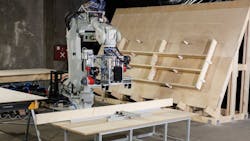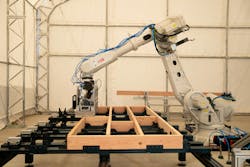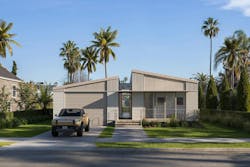Q+A: Sasha Jokic's Unique Approach to Resilient Building
Key Takeaways:
- Cosmic combines robotics and AI to build customizable, fire-resistant homes quickly and cost-effectively.
- Cosmic is supporting wildfire recovery efforts in Pacific Palisades and Altadena.
- Cosmic's software interprets local building codes and generates compliant designs, streamlining permitting and reducing project timelines.
This article first appeared in the September/October issue of Pro Builder
Since founding Cosmic Buildings in 2021, Sasha Jokic has been reimagining how homes can be built, especially in areas affected by wildfires. Based in San Francisco, Cosmic combines robotics and resilient design to create homes that are not just fire-resistant but also customizable and quickly assembled in mobile “micro-factories” that are easily transported and set up on site. In addition to directing the robotics that build custom modular homes to any style and size, the company’s AI-enabled software also interprets local building codes, generates compliant designs, and streamlines permitting for a faster turnaround—an approach that exceeds California’s wildfire and energy codes and creates a one-of-a-kind post-wildfire recovery solution.
PRO BUILDER: What is Cosmic’s origin story, and what inspired you to start it?
Sasha Jokic: Cosmic was really in response to the severe housing crisis we have nationwide. As someone with a background in construction, robotics, and architecture, I was really motivated to improve how we build.
A big focus was building homes that are better for both people and the planet, so building sustainable, resilient homes became part of our DNA from day one.
One thing I always add is that we’re a mission-driven company. We’re not just saying it; we are incorporated as a public benefit corporation, which reflects our commitment to building sustainable, resilient housing at scale.
Alongside Cosmic, we launched the Cosmic Foundation. Our first project under the foundation is the “One to Ten” initiative, where we donate one home for every 10 we build. That’s currently underway in Altadena (a community wiped out by the Los Angeles fires earlier this year), where we’re focused right now.
PB: How does your micro-factory approach work?
SJ: The core idea is mobility. Traditional prefab (housing) relies on large factories that ship panels or modules to job sites, but that model doesn’t scale well. And transporting panels more than 300 miles just isn’t practical.
Building a traditional prefab factory can cost up to $100 million and takes three to four years, plus a large workforce. What we’ve created is the opposite—a compact, mobile factory that fits on a small truck, can be deployed in a day, and operates with full automation.
Our robotic micro-factory builds wall panels on-site. These are then assembled into a structural shell. This approach is up to 10 times faster and significantly lowers costs. Because we’re an end-to-end system—including design, fabrication, and assembly—we’re able to reduce total cost by up to 30% and speed up timelines by about three times.
PB: What’s your involvement with the Los Angeles wildfire recovery efforts?
SJ: Right now, in Pacific Palisades, we’ve deployed our first mobile robotic factory. We’re supporting a pipeline of homeowners that helps them rebuild and return to their properties.
One thing we’re proud of is that our product is both sustainable and fire-resistant. In areas like Pacific Palisades and Altadena, it’s critical to provide housing that helps people feel safe in the event of future natural disasters. Our homes exceed the most stringent fire codes, specifically for designated Wildland-Urban Interface areas.
PB: What would you say is the average timeline, from start to finish?
SJ: We generally break it down into four main stages: design, permitting, fabrication, and on-site assembly, including the foundation. Once permits are approved, we typically quote four to six months for completion.
We start with the foundation, then build the structural shell on-site using our robotic factory. The rest—facades, roofing, and interiors—are fabricated off-site and delivered as a flat-pack.
PB: How is AI implemented in your process?
SJ: At Cosmic, we have a world-class team working on tech that, until recently, lived mostly in academic or future-facing discussions.
We’re building a fully digitized, end-to-end process, starting with design. We take client input, then use AI to interpret local building and zoning codes to ensure compliance. We generate a custom 3D model that includes all the data needed for fabrication and assembly.
That data is used to train the robotic arm in our micro-factory. There’s no human handoff between design and fabrication—it’s a direct pipeline. The robot knows what to pick up, where to place it, and how to assemble it, including where to insert nails or screws.
The real magic is that we’re using reinforcement learning. Each time we build a panel, we capture data that informs future designs and builds. That feedback loop improves everything from design to fabrication to on-site assembly.
RELATED:
- Taking a Thoughtful Approach to Home Building
- Steve Ruffner's Journey to Build Wildfire Resilient Homes
- 3 Factors That Amplify a Building's Resilience
PB: What else should the housing indsutry know about your approach?
SJ: AI and robotics are solving the industry's biggest problems—cost and time—without sacrificing customization. For the first time, we can create beautiful, custom homes with prefab-like efficiency. That just wasn’t possible before.
Cosmic is helping redefine the narrative. You no longer need to compromise on design to gain speed or savings. That’s a huge shift.
About the Author

Catherine Sweeney, Associate Editor
Catherine Sweeney is the associate editor for Pro Builder and Custom Builder Online.



